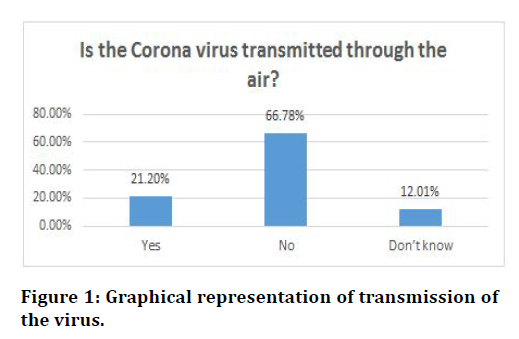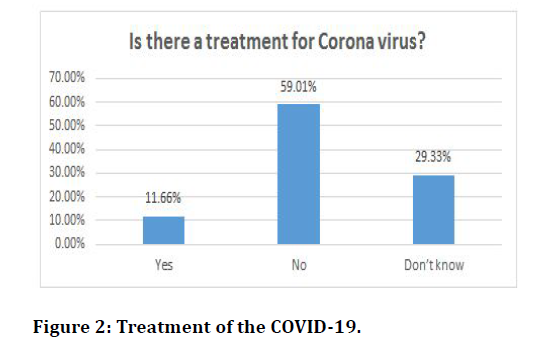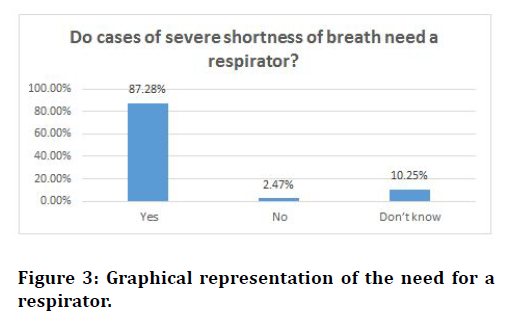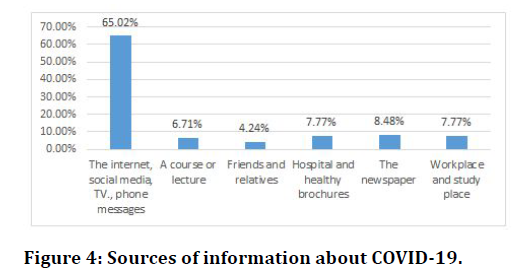Research - (2022) Volume 10, Issue 2
Awareness of the Haâil City Population towards Coronavirus and Methods of Prevention
*Correspondence: Nagwan Elhussein, Department of Diagnostic Radiology, College of Applied Medical Science, Ha’il, Saudi Arabia, Email:
Abstract
Background: The outbreak of the COVID-19 has been a matter of concern for the whole world. Meanwhile, its awareness is also very important since the cooperation of the public and the population seems to be the only way of preventing the spread of the virus. Methodology: The survey was conducted from the public of Ha’il city while the questionnaire contained different types of questions including their demographics as well as the questions related to the awareness of the COVID-19. Results: The majority of the participants tend to have the basic knowledge of the virus however, there is still a figure that lacks awareness and is not taking the necessary measures. The administration can provide an exclusive plan of awareness in order to avoid adverse effects. Conclusion: The research concludes that the basic awareness of the COVID-19 is present to the literate population. The study provides generalized outcomes through the selected cohort of the study.
Keywords
COVID-19, Virus awareness, Coronavirus prevention, Symptoms of corona
Introduction
The recent outbreak of the pandemic known as COVID-19 has been a matter of concern for the whole world. it is the matter of fact that it has affected the whole world on a noteworthy scale while many have suffered from worse scenarios. Since there is still no absolute solution introduces for the virus, the only way to stop its adverse effects is to prevent it. However, it has been challenging to provide authentic awareness to the public. There are a number of different perceptions that can be found for the virus while many of them are the myths. It is important to provide the proper information to the public due to the sensitivity of the situation. Numbers of studies and researches elaborate on the current pandemic while according to the reports its background started at the end of 2019. a series of pneumonia cases of unknown cause emerged in Wuhan, Hubei, China. Following the pneumonia cases reported in Wuhan and shared history of exposure to seafood stores for all COVID -19 Patient an epidemiological alert and warning was released by the local health authority on Dec 2019, more than 50 - suspected cases with fever and dry cough were transferred to a hospital starting from Dec 31, 2019 [1]. An expert team of physicians, Nurses, pharmacist epidemiologists, virologists, and government officials were soon formed after the alert [2]. In addition, according to the National Health Commission of China and Ethics Commission of Jin Yin-tan Hospital (KY-2020-01.01). The Ethics Commission of the designated hospital for emerging infectious diseases. In January 2020, the “World Health Organization” (WHO) defined SARS-CoV-2 responsible for the disease (COVID-19) some of the cases asymptomatic cases to severe respiratory involvement (WHO Novel coronavirus, 2020). On March 9th, 2020, WHO considers that COVID-19 a global pandemic [3]. Italy also is the second most affected country by COVID-19 infection after China. The outbreak of the viral disease has become a matter of concern on the global level [3].
Ever since the outbreak, researches have been looking into various approaches to prevent chaotic conditions of the world while the most optimized solution found till now is to prevent its spread which requires public cooperation. The research-based on the awareness of the Ha’il City Population Towards Coronavirus and Methods of Prevention.
Methodology
The research is based on the descriptive quantitative approach since it targets the general participants from the population of Ha’il. The survey was conducted in order to find the information from the participants. Total n=283 numbers of participants' data were finalized for the research article.
Results
The data from the participants were taken from different sources. Moreover, these participants were asked for multiple questions in order to obtain optimized results. Total of 283 participants was selected for the research while the majority of the participant were from age group 15 to 30 years i.e. 54.77%. Other than this 25.8% of the participants were from age group 31 to 40 years and others were over 40 years old.
The data of the participant further contains other demographics including the information of their gender. 85% of the participants were female while 14.8% were male.
Moreover, demographical data contains information about their education level. The majority were university students that made up 64.6% of the total number of participants. However, 17.67% were secondary students while the rest were alimentary, intermediate, diploma, and postgraduate. In addition to this, demographics also contained data about participants’ profession. 38.16% of the participants were students while 9.5% were from the administrative sector and 17.31% of participants were from the educational sector.
According to the majority of the results of the participants’ High fever, pain in the throat with coughing, Severe shortness of breath while the symptoms were quite similar overall. The common point or symptom was the high fever, pain in the throat, and shortness in breath. The participants were asked for the multiple combinations of the symptoms.
Another part of the results exhibits awareness about the spread of the COVID-19 questions. The most common cause was the Flying mist from the patient while sneezing or coughing, Touching contaminated surfaces and tools, Direct contact with the COVID-19 patients. The further results are briefed in Table 1.
| How does the COVID-19 spread (infection)? | Frequency | Percentage |
|---|---|---|
| Flying mist from the patient while sneezing or coughing | 9 | 3.18% |
| Flying mist from the patient while sneezing or coughing, Direct contact with the COVID-19 patients | 25 | 8.83% |
| Flying mist from the patient while sneezing or     coughing, Direct contact with the COVID-19 patients, Direct contact with the COVID-19 animals | 2 | 0.71% |
| Flying mist from the patient while sneezing or coughing, Touching contaminated surfaces and tools | 5 | 1.77% |
| Flying mist from the patient while sneezing or coughing, Touching contaminated surfaces and tools, Direct contact with the COVID-19 patients | 153 | 54.06% |
| Flying mist from the patient while sneezing or coughing, Touching contaminated surfaces and tools Direct contact with the COVID-19 patients, Direct contact with the COVID-19 animals | 47 | 16.61% |
| Flying mist from the patient while sneezing or coughing, Touching contaminated surfaces and tools, Direct contact with the COVID-19 animals | 1 | 0.35% |
| Direct contact with the COVID-19 patients | 19 | 6.71% |
| Touching contaminated surfaces and tools | 4 | 1.41% |
| Touching contaminated surfaces and tools, Directcontact with the COVID-19 patients | 16 | 5.65% |
| Touching contaminated surfaces and tools, Direct contact with the COVID-19 patients, Direct contact with the COVID-19 animals | 1 | 0.35% |
| Don't know | 1 | 0.35% |
| Total | 283 | 100.00% |
Table 1: Perception of the participants about the spread of the virus.
Along with the different perceptions on the current pandemic, another aspect that was inspected as the perspective of the population was as if the virus can be transmitted through the air however majority of the participants were negative about it Figure 1.

Figure 1. Graphical representation of transmission of the virus.
Further participants were asked for the knowledge about the treatment of the virus whereas 59% said that there is no treatment found for the CVID-19. Significant numbers of participants did not have knowledge about certain conditions as in Figure 2.

Figure 2. Treatment of the COVID-19.
Since shortness of the breath was one of the most common symptoms of the virus it was further investigated as a single entity in an order to know if there was a necessity of respirator in case of appearance of the symptom and it was found as the major need of the disease. The need was detected about 87% briefed in Figure 3.

Figure 3. Graphical representation of the need for a respirator.
In order to understand more about the awareness on COVID-19 especially from the perspective of its prevention, the participants were asked for the measures and their importance to prevent the spread of the virus. The list of the measures is given as follow:
Keep washing your hands well.
Use a handkerchief or arm when you cough or sneeze.
Avoid contact with eyes and nose before washing hands.
Avoid direct contact with the patients and not sharing their tools.
Drink plenty of fluids.
Leave a distance of at least a meter and a half between people in gathering places.
Use gloves and disinfectants when out of the house.
The majority of the participants agreed that all the measures are important for the prevention of the virus while significant numbers of participants did not feel the necessary need for increased intake of fluids. Very few did not agree with the factor like washing hands and using a handkerchief.
Participants were further asked if they are taking these measures on a daily basis and the majority of them agree i.e. 70.6% while other participants were not regular with following the SOP showed in Table 2.
| Do you apply prevention methods in your daily life? | Frequency | Percentage |
|---|---|---|
| Yes | 200 | 70.67% |
| No | 3 | 1.06% |
| Sometimes | 49 | 17.31% |
| Part of it | 31 | 10.95% |
| Total | 283 | 100.00% |
Table 2: Prevention measures.
The participants were further asked if they think that the vaccination are are useful to stop the spread of the virus.
97% of the participants agreed that these measures help to prevent the virus from spread Table 3.
| Do you agree that the vaccination prevent the spread of the virus? | Frequency | Percentage |
|---|---|---|
| Yes | 275 | 97.17% |
| No | 5 | 1.77% |
| Don’t know | 3 | 1.06% |
| Total | 283 | 100.00% |
Table 3: Assurance of the precautionary measures.
The research results were concluded by obtaining the sources of the participants that were utilized to know about the COVID-19. 65% of the participants got awareness via the internet and online courses while others got to know about it from other sources like lectures, training, friends, and relatives (Figure 4).

Figure 4. Sources of information about COVID-19.
Discussion
The research is based on the agenda of the awareness about the COVID-19 in the general population in a particular region. A total of 283 participants gave the data for the results extraction while the awareness in the majority of the participants was on a satisfactory level. Since participants were literate while many of them were professional, they had access to the sources of awareness. The graphs and tables provide detailed data and analysis of the results and further exhibits the factors that are useful for the research. The research can be useful to spread furthermore awareness in the public in order to prevent the adverse effects of the current pandemic. Stats have been increased on the consistent level while no absolute solution for the outbreak has been discovered [4]. Major parts of the world are facing lockdown situations while it is affecting the world economically as well [5]. Perhaps the rate of fatality is not higher than other viruses, the pandemic nature of the virus has created significant chaos all over the world [1]. The outbreak of such a virus has immense effects not only in terms of the fluctuation in the mortality and the morbidity rate [6], but also on other factors such as the economy and environment. Amidst a global pandemic, the first approach towards controlling the situation is to declare a lockdown that helps contain the outbreak, however, it causes irreversible damage to the worldwide economy [7]. The lockdown includes the shutting down of all industries and supply chains [8], the consequences of which are evident in the form of the dropping production of the country [5]. Developed nations like China and the United States of America are a source of product supply for a number of other countries and due to the lockdown, the condition of the economy of both the developed and the underdeveloped countries is jeopardized [4]. The transport also shuts down as a result of the viral outbreak which further contributes towards the deteriorating economy because of the limited transportation of goods across and within the countries while the drastic change in public transport has also affected the environmental change [9]. The potential economic damage that is likely to be caused by the - COVID 19 is to a great extent and hence the need to eliminate the outbreak in every possible way is vital [10]. It is the responsibility of the authorities to take the safety measure by every mean [3] whereas if unfortunately, the government all over the world fails to take measures regarding the pandemic the economy will collapse leading to a rise in poverty and chaos [11,12]. Meanwhile, along with the responsibility of the authorities, it is further important to spread awareness in the public since the outbreak can only be prevented with the cooperation. That is why this research focusses on the perception of the public and provide information about the current knowledge of the public regarding the COVID-19. The results of the research show that population of Ha’il is much aware of the condition and is taking the measure to prevent the virus, however, there are still numbers of people who are not aware of the situation and severances very well.
Conclusion
The research is based on the awareness of the current pandemic COVID-19 and the target of the research is the population of hail. The research was conducted in different parts while participants were asked a different question via a survey in order to know about their understanding of the COVID-19. The results seem to be satisfactory however the numbers can be improved if the authority sets up some training and awareness campaigns for the public. The research further concludes the perception of the public regarding symptoms of the virus and the public was found to be aware of the common symptoms.
References
- Huang C, Wang Y, Li X, et al. Clinical features of patients infected with 2019 novel coronavirus in Wuhan, China. Lancet 2020; 395:497-506.
- Lai CC, Shih TP, Ko WC, et al. Severe acute respiratory syndrome coronavirus 2 (SARS-CoV-2) and coronavirus disease-2019 (COVID-19): The epidemic and the challenges. Int J Antimicrob Agents 2020; 55:105924.
- https://www.who.int/emergencies/disease-outbreak-news/item/2020-DON233
- Velavan TP, Meyer CG. The COVID-19 epidemic. Trop Med Int Health 2020; 25:278.
- Gorbalenya AE, Baker SC, Baric R, et al. Severe acute respiratory syndrome-related coronavirus: the species and its viruses: A statement of the coronavirus study group. Bio Rxiv 2020.
- Richman DD, Whitley RJ, Hayden FG. Clinical virology. 4th Edn. ASM Press, Washington 2016.
- Nicastri E, Petrosillo N, Ascoli Bartoli T, et al. National institute for the infectious diseases “L. Spallanzani” IRCCS. Recommendations for COVID-19 clinical management. Infect Dis Rep 2020; 12:3-9.
- Morse JS, Lalonde T, Xu S, et al. Learning from the past: Possible urgent prevention and treatment options for severe acute respiratory infections caused by 2019-nCoV. Chembiochem 2020; 21:730-738.
- Huang C, Wang Y, Li X, et al. Clinical features of patients infected with 2019 novel coronavirus in Wuhan, China. Lancet 2020; 395:497-506.
- Wang M, Cao R, Zhang L, et al. Remdesivir and chloroquine effectively inhibit the recently emerged novel coronavirus (2019-nCoV) in vitro. Cell Res 2020; 30:269-71.
- Wu J, Liu J, Zhao X, et al. Clinical characteristics of imported cases of COVID-19 in Jiangsu Province: A multicenter descriptive study. Clin Infect Dis 2020; 10.
- Chen N, Zhou M, Dong X, et al. Epidemiological and clinical characteristics of 99 cases of 2019 novel coronavirus pneumonia in Wuhan, China: A descriptive study. Lancet 2020; 395:507-513.
Indexed at, Google Scholar, Cross Ref,
Indexed at, Google Scholar, Cross Ref,
Indexed at, Google Scholar, Cross Ref,
Indexed at, Google Scholar, Cross Ref,
Indexed at, Google Scholar, Cross Ref,
Indexed at, Google Scholar, Cross Ref,
Indexed at, Google Scholar, Cross Ref,
Indexed at, Google Scholar, Cross Ref,
Indexed at, Google Scholar, Cross Ref,
Author Info
Department of Diagnostic Radiology, College of Applied Medical Science, Saudi ArabiaReceived: 26-Jan-2022, Manuscript No. JRMDS-22-54360; , Pre QC No. JRMDS-22-54360 (PQ); Editor assigned: 28-Jan-2022, Pre QC No. JRMDS-22-54360 (PQ); Reviewed: 14-Feb-2022, QC No. JRMDS-22-54360; Revised: 18-Feb-2022, Manuscript No. JRMDS-22-54360 (R); Published: 25-Feb-2022
